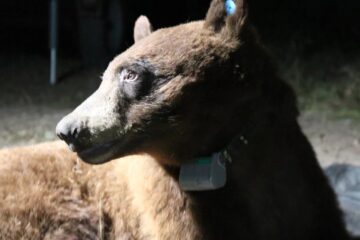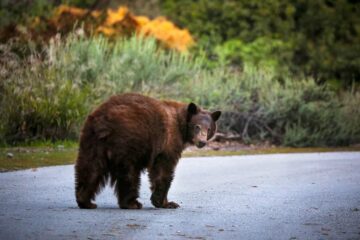Hunt Continues for Jungle Cat on the Loose in Simi
Search continues for a 400- to 600-pound cat in the hills between Simi Valley and Moorpark.
Source of this article – Los Angeles Times, February 20, 2005.
By PAUL PRINGLE, Times Staff Writer
Pistol on his hip, Chris Long .ramped along a muddy trail Saturday following the saucer-sized paw prints of what might or might not be an African lion, stalking the green hills between Simi Valley and Moorpark.
“It crossed the freeway right there,” said Long, a state Fish and Game Department warden, pointing beyond a rain-soaked horse pasture to California 23. “It could be on either side of the freeway now. We just don’t know.”
 Long was supervising the suburban safari that took government trackers into the oak-shaded canyons behind the Ronald Reagan Presidential Library, in pursuit of an animal believed to be 400 to 600 pounds.
Long was supervising the suburban safari that took government trackers into the oak-shaded canyons behind the Ronald Reagan Presidential Library, in pursuit of an animal believed to be 400 to 600 pounds.
A few sketchy sightings and the discovery of dozens of the four-toed, 6-inch prints had the search parties scouring the area for the third straight day, without result.
Five two-person teams looked for signs of the animal along the freeway and Olsen Road, below ridges lined with houses. They responded to fresh reports of prints or were guided by a helicopter equipped with a infrared sensor.
On Saturday night, three cage-type traps set for the animal were empty. Where the creature came from also remained a mystery.
“There are a lot of possibilities,” said Long, as he peered at a hillside where an animal resembling a lion had been seen chasing cattle. “It could have been kept legally or illegally nearby. Or it could have traveled some distance.” The hunt for the wayward beast had Simi and Moorpark buzzing with nervous wonder, and concern for the animal’s fate.
“One woman has called us three times and said she has a prayer chain going at her church,” said Fish and Game spokeswoman Loma Bernard.
“They are praying for a happy ending.”
So were neighbors of the property where ranch hand Luis Romo spotted the animal on Tuesday. “It scared me,” Romo, 28, said Saturday. “It was amazing.”
Sheriff’s deputies have warned hundreds of residents to keep an eye on their pets and a short leash on their children. Romo’s family has stayed indoors, and he regularly checks the 220-acre ranch with a pair of binoculars.
“Everybody here is talking about it,” said Dorian O’Connor, 60, who lives in Simi and cuts hair at a salon just down the road from where the prints were found. He said he has persuaded his wife, Terri, to forgo her nightly strolls until the animal is captured or killed.
“She said, ‘Let me take your gun on my walk,'” recounted O’Connor, who also works as a security guard. “I said, ‘No way.’ … I always hated going to the zoo because I don’t like seeing animals in cages. Well, I say put this one in a cage.”
At Moorpark High School, teachers have tried to make light of the unfolding lion tale, said student Vanessa Issa, 16. “They don’t want people to go into a mass panic,” she said. “It’s a little frightening, but it’s also a little interesting to have this great beast around. I’d probably take a picture of it if I saw it, before I ran off screaming.”
Long and other Fish and Game officials said they still weren’t entirely certain of their quarry’s species. It could be a tiger, they said.
But they have ruled out the possibility of a freakishly overgrown mountain lion, a native predator that typically tips the scales at no more than 120 pounds.
Monitoring the hunt from afar were fretful caretakers of exotic animals, including former actress Tippi Hedren, who runs the Shambala sanctuary in Acton.
“He’s going to be disoriented,” said Hedren, whose rescue operation houses numerous lions, most taken from private owners. “He’s probably going to get hungry. He’s going to start looking for water.”
Hedren and a consulting veterinarian to the sanctuary, Martin Dinnes, feared that the wardens would be too quick to kill the animal, rather than tranquilizing or trapping it. “Fish and Game usually isn’t too successful at these operations,” said Dinnes. “My guess is that if they see this cat, their first inclination will be to kill him.”
But he said it was unwise to underestimate the danger posed by an African lion, if that’s what the animal turns out to be. “The hungrier he gets, the more likely it is he will eat a human,” Dinnes said.
 Long said his trackers will do their best to take the animal alive. “Our goal is to capture it, but we’re concerned about public safety.”
Long said his trackers will do their best to take the animal alive. “Our goal is to capture it, but we’re concerned about public safety.”
Wardens have set one trap on the west side of the highway and two more at the Dry Creek Ranch, where Romo saw the hindquarters of the animal fleeing into a thicket of mulefat bushes beside a pond.
The so-called culvert and box traps have been baited with fryer chickens from a local grocery, and are equipped with triggered doors.
If the animal crawls in to feast on the fowl, the door will slam shut behind it.
Bernard said trackers on loan from the U.S. Department of Agriculture are leading the hunt. She said they did not want to be interviewed or identified because people in their line of work are sometimes vilified for killing an animal.
A worry for the trackers is whether a single tranquilizer dart can immobilize an animal in the 400-pound-plus range. “It’s going to take a couple of them,” Bernard said.
Even with two darts, it would take 10 minutes or so for the tranquilizer to immobilize the animal, Long said.
But first the trackers have to find it, he noted.
“Cats are nocturnal,” said Long, as he examined a pattern of prints partly washed away on a dirt road, the roar of freeway traffic echoing across the ranch. “Generally, in the daytime, they will sleep. They will find some dense cover.”
On Saturday afternoon, the Ventura County Sheriff’s Department provided the helicopter for aerial searches.
One report of new prints sent the trackers to a remote location about 10 minutes from the ranch, but it proved a false alarm. “They were bear tracks,” said Long.
Michael Dee, general curator for the Los Angeles Zoo, said it is hard to predict how the animal might behave in the Simi back-country.
“If it was someone’s pet, that doesn’t mean it’s going to be nice if someone runs into it,” Dee said. “This is an animal that could be the tamest lion in the world, but if it comes running at you, even in a playful mood, you don’t know that.”
A lion could survive indefinitely by feeding on deer and smaller prey in the hills, he said. But it is likelier to stumble into the path of a car, Dee said.
“It’s probably pretty frightened,” he said. “I feel sorry for the animal.”
An estimated 10,000 to 15,000 big cats are kept in private ownership in the United States — most of them tigers, which are prized for their bright colors, zoologists say. Animal rights activists have lobbied for tighter restrictions on domestic ownership of lions and tigers.
The investigation of the lion sightings near Simi had initially focused on a makeshift exotic-animal farm that was forced to move five lions and tigers earlier this month because of permit violations and inadequate cages, Long said.
The property is visible from Dry Creek Ranch.
Fish and Game officials, however, said the farm’s lions and tigers had been accounted for, as far as the agency could tell. Its owners could not be reached for comment.
Word of the hunt, meanwhile, surprised some visitors to the hilltop Reagan Library, which overlooks the ranch and much of the rolling land between Simi and Moorpark.
“An African lion?” said Suman Gandham, who lives in Oak Park. His eyes widened, and then narrowed. “I’d like to get a look at it, but I wouldn’t get too close.”


